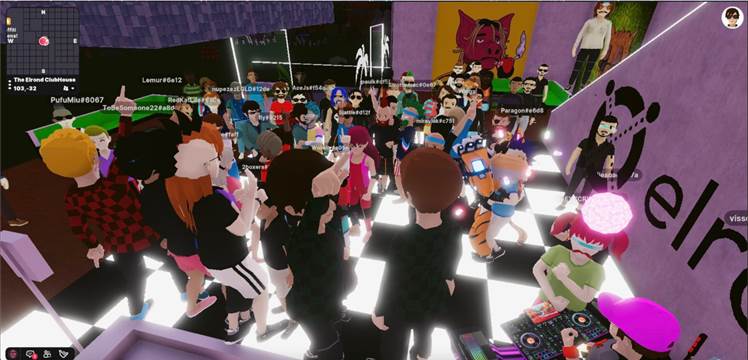Musical artists Hi-Rez the Rapper and Wiz Khalifa released their single Bye Haters in the metaverse last week. But rather than chasing a mass audience, they delivered a hint of something potentially much more powerful, and transformative — intimacy across a global scale.

The ability of the music industry to deliver massive events online is already understood (in fact, it was pioneered almost two decades ago in Second Life).
In 2020, Lil Nas X for instance reached an audience of 33 million over four days in one of the first virtual concerts. The Rift Tour on Fortnite in 2021 headlined by Ariana Grande drew over 27 million viewers, according to marketing publication, The Drum.
Both of these events utilised mature stable gaming platforms. Decentraland by contrast is an open-source metaverse owned by its users.
From little things, big things grow.
Last week in a virtual 16 by 16-metre room built on a block of land in Decentraland, the avatars of more than 300 fans of musicians Hi-Rez the Rapper and Wiz Khalifa danced their night (and day) away in a metaverse song release where the two artists launched their musical collaboration Bye Haters.
Between them, the two artists have already achieved scale online with almost 28 million fans across their respective YouTube channels. But last week's event was noteworthy for its intimacy and for that the fact that it took place in a metaverse, rather than in a more stable and risk-free mature gaming environment such as on the Roblox platform, or in Fortnite.
And while small, the launch of Bye Haters was not without significance — or risk. When Digital Nation first spoke with Hi-Rez in the days leading up to the event, he acknowledged he had no real idea how well the experience would hold up.
His first impression was delivered to Digital Nation immediately afterwards via a Twitter DM: “Was so epic, man.”
Later he elaborated.
“Decentraland’s server needs a lot of improvement but beyond that everything in my control went as great as it could have been. Every fan had such a new and fun experience that they've never had in the past and are looking forward to many more to come,” he said.
Hi-Rez's move into the metaverse reflects engagement with the Web3 ecosystem but is also a consistent lifelong commitment to taking chances on new technology. He was an early mover on YouTube, for instance.
“I was there within the first year or two of its inception before there were even ads on YouTube before there were more even a couple of thousand channels in existence.”
More recently he has been exploiting the flexibility of NFTs, effectively creating an opportunity for early adopters of his Hog Homies projects to share in the financial benefits of his innovations through passive income (and indeed from a very tidy capital gain). Lately, he has also released a second generation of NFTs that carry all the hallmarks of a contemporary corporate loyalty program providing his fans exclusive access and experiences.
Artists such as Hi-Rez see a new world of commercial opportunity for music in the metaverse, as well as a very different and potentially much more engaging chance for fans to mix and mingle with their favourite performers in ways that are simply impossible in the world of real things.
“You get to hang with your supporters in a fun safe and intimate way that you couldn't even get to do in real life if given the chance,” Hi-Rez told Digital Nation.
He, like a lot of artists, also recognises that Web3 offers to deliver the promise of a creator-economy where the artists themselves can define the benefits of their success. That's a very different world to the one ushered in first by Napster, and later by platforms like Spotify which atomised the revenues of those who actually create content.
For this reason, the expansion of music into the metaverse could prove to be transformational, as Victoria Copans, writing for XLive last year noted.
Copans identified three potential lines of disruption;
- As with the Hi-Rez and Wiz Khalifa event last week, artists are able to open up a direct connection to fans.
- The worlds of gaming and music are merging creating potentially new business models.
- And fans are provided with an opportunity to contribute to the creative process.
For all the potential, these are early days, and analysts have pointed to the lack of established and robust infrastructure as an impediment to more rapidly metaverse expansion.
It’s something Hi-Rez recognises. “Right now with the present technology it's so wishy-washy and we're so early that there are not many people walking around these games. It's very glitchy and it has a lot of bugs.
"Things are decentralised so it's not like a traditional centralised game that has an office with a bunch of people working on it all time. It’s not like the way we think of Ubisoft or any of these other traditional gaming companies who could just update things with the drop of a hat.
“I think that it's going to take time."
But in the run-up to his metaverse moment, Hi-Rez was focused on the opportunity.
“I have hundreds of people this Thursday meeting me in a virtual world that looks like a Minecraft game, all to listen to one song on loop while I do giveaways and we dance.”
“That sounds nuts to me,” he told Digital Nation, “But in a great way.”


_(22).jpg&h=140&w=231&c=1&s=0)

_(20).jpg&h=140&w=231&c=1&s=0)
.png&h=140&w=231&c=1&s=0)





 iTnews Executive Retreat - Security Leaders Edition
iTnews Executive Retreat - Security Leaders Edition












_(1).jpg&h=140&w=231&c=1&s=0)



